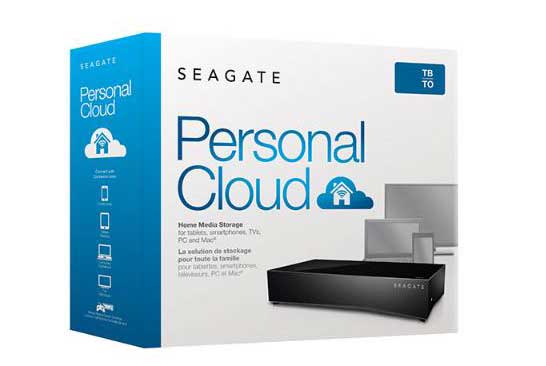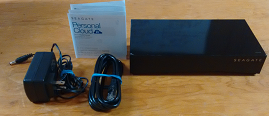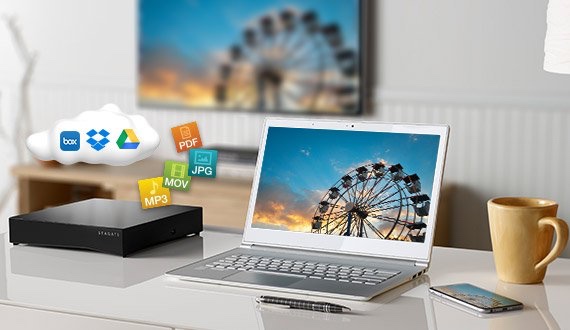
The Seagate personal cloud home media storage device is a solution to a variety of little problems that I didn’t know I had. My home computer network is a collection of separate devices, each its own data fiefdom. The photos on my phone sit on there until I eventually get around to plugging it in to my laptop to transfer them. Or, as is often the case, I decide it’s too much bother and I leave my phone’s SD card packed full of unsorted pictures. And the less we talk about my computer backup routine (or total lack thereof), the better. I had grown accustomed to the process of manually moving files from one place to the other. It’s an arrangement that really cries out for a network attached storage (NAS) but I stuck with the status quo because I thought the alternative would be an irritatingly complex solution to set up. With that in mind, I reluctantly pulled the Seagate Personal Cloud home media storage device out of the box, bracing myself for a set-up ordeal.
Easy Set-Up and Configuration
 The first surprise? No printed manual. I know that the trend has been to provide robust digital or online documentation, but I still expected more than foldout pictorial quick start guide. This isn’t a knock against the provided printout, which did the job of demonstrating the physical setup steps. Once the hard drive had initialized (a process that took around 10 minutes), the device was visible on the network. Clicking on the drive automatically brings you to the browser-based administration page, which was a nice touch.
The first surprise? No printed manual. I know that the trend has been to provide robust digital or online documentation, but I still expected more than foldout pictorial quick start guide. This isn’t a knock against the provided printout, which did the job of demonstrating the physical setup steps. Once the hard drive had initialized (a process that took around 10 minutes), the device was visible on the network. Clicking on the drive automatically brings you to the browser-based administration page, which was a nice touch.
The basics of configuration were straight forward and without any surprises. With my primary user account fully configured, it was time to test it out.The Seagate Personal cloud home media storage device offers a wide array of features. First and foremost, it’s an external hard drive for centralized file storage. As storage devices go, it was up to the task. I threw my 30+ GB music library over to the drive and accessed it with my PC, streamed it through my Xbox One, and browsed it on my android phone using the Seagate Media app. The list of compatible streaming solutions is impressive: the personal cloud can stream to iTunes, chromecast, Samsung and LG smart tvs, mobile devices running the Seagate Media app and all DLNA enabled devices. The files stored on the drive can be accessed remotely via the Seagate Access service, as well as on your local network.

You can easily create user accounts and restrict the access granted to that account, so no one sees anything they shouldn’t see. No one wants young Johnny to ‘accidentally’ start streaming a terrifying R-rated horror movie for his friends huddled around his laptop. It’s remarkably easy to set up a remote user account as well, which opens the door to more flexible file sharing for collaborative projects. A real selling feature for the work from home crowd, or for sharing family photos and movies with mom and dad back home.
Data Backups and Social Media Syncing
It also has integrated backup software for both your home computers and your mobile devices. For your mobile backup you’ll need to create another account, this time with Seagate Dashboard. I’m not sure why the Seagate Access account couldn’t be used for both instances: it seems like the left hand of Seagate doesn’t know what the right hand is doing. Nevertheless, it was a painless setup up and a mostly error-free execution. My phone’s backup routine had a couple of errors when triggered manually, but the nightly automatic backup was consistently successful.
It also allows you to sync your social media accounts (Facebook and Flickr), to upload new photos to either service, or to download existing photos to your personal cloud drive. As someone who occasionally posts photos to Facebook without keeping a copy anywhere else, this sync option is handy. On the other hand, it seems like it is more work to upload photos via the cloud drive than directly into Facebook. And, you can choose to sync your files with a cloud storage service you may already be using, like Google Drive or Dropbox. This is a good option for ensuring that you have all your files where you expect them to be. If you’re not paying for a full cloud storage account, you’ll have to be more selective on what files and folders are included in the sync to avoid hitting your cloud storage limit.

The drive also has the capability to install and run applications to add supplementary functionality, like BitTorrent sync. BitTorrent Sync is a secure device-to-device transfer app that avoids having your data temporarily located in an intermediary storage location. It’s not a feature that most casual users will ever look for, but the option for more rigorous file security is nice. The selection of add-on applications is sparse, and I doubt that I’d get much use out of the app manager area after the initial setup.
To round out the suite of offered functionality, the Seagate Personal Cloud home media storage device has a download manager. It can manage up to 5 concurrent BitTorrent, FTP or HTTP file download, saving you the trouble of downloading the file first to your laptop and then transferring to the personal cloud drive. The download manager is as barebones as you can possibly get. It provides the absolute minimum of configurable settings and has no additional controls or features, so anyone used to a more robust download manager will be disappointed.
Simplified, All-in-One Media Storage Solution
Overall, it turns out that I am the target market for the Seagate Personal Cloud. I don’t have any existing NAS in place, but I have a variety of devices holding my files with no centralized method of organizing and protecting them. If I had solutions in place that offered the same features as the personal cloud, I might be disappointed with the simple approach of the Seagate drive when compared to my existing setup. But, as a brand new NAS user, the Seagate Personal Cloud media storage device offers the right mix of features without being overly complex and difficult to configure. And at the end of the day, it is usability that dictates how valuable a device is to you.
Images from Seagate.com



